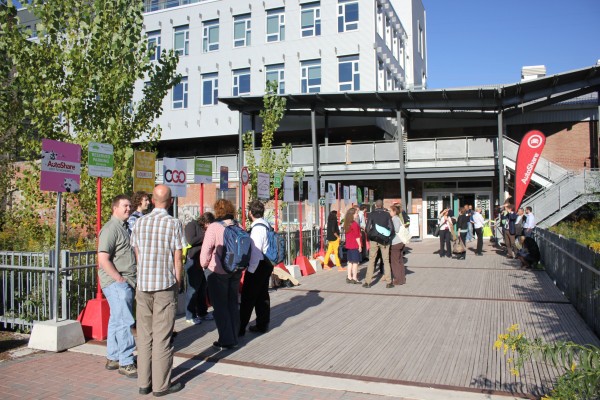More young urban dwellers don’t want to own a car — which is bad news for the automotive industry, but good news for the burgeoning car sharing industry.
The growth in popularity of car sharing was obvious at the CarSharing Association’s 2013 Shared Mobility and Transit Conference, Sept. 16 and 17, at the Evergreen Brick Works, which saw a packed room full of industry representatives, public planning professionals, academics and entrepreneurs.
Young people’s aversion to car ownership was a recurring theme at the conference. AutoShare President Kevin McLaughlin, in a written introduction to the event, said a 2012 study found a 23 per cent drop in ownership among people ages 16 to 34, between 2001 and 2009 alone.
That’s a pretty significant drop; and, as Toronto Chief Planner Jennifer Keesmaat told the audience, it may mean that cities which fail to adapt to this change — through better access to various modes of travel, shorter commute times, and greater walkability — run the risk of losing the coveted Millennial generation, which would be bad.
“Cities without this cohort are at tremendous risk,” Keesmaat said. “Because they don’t have a future.”
Keesmaat said when the Baby Boomers eventually retire, it will create “a significant talent vacuum.”
Cities need Millennials to fill that vacuum. Car sharing may be part of what it takes to entice young Canadians to urban centres.
Regional transit agency Metrolinx is already preparing to integrate car sharing into the GTHA transportation network. Antoine Belaieff, Metrolinx’s director of innovation, told the conference 60 per cent of GO Rail users drive themselves to the station, filling the services 65,000 parking spaces, fast.
“We’re running out of land,” Belaieff said.
To address this, Metrolinx has already introduced the Carpool to GO program, which provides dedicated carpool parking at 24 stations, Belaieff said.
Additionally, Belaieff said Metrolinx is currently selecting and finalizing a partner from the car share industry. Once the contract is awarded, there will be dedicated car share spaces available at GO Rail stations for those who only need access to cars on occasion.
Metrolinx has already sent out a Request For Proposal, and the contract will be awarded soon.
photo by Glyn Bowerman



4 comments
“To address this, Metrolinx has already introduced the Carpool to GO program, which provides dedicated carpool parking at 24 stations, Belaieff said.”
The cynic in me says that the above paragraph should read like this:
“To address this, Metrolinx has spent millions of dollars on new parking garages, which provides thousands of additional parking spots at seven of our stations, Belaieff said.”
GO complains that they’re running out of land, which is true. I just find it disappointing that the answer to that problem is even more parking, even as auto ownership rates start to fall.
Hi Sean,
Good point. I was under the impression they converted existing parking into carpool spots, but nothing in my notes is definitive. I will try to dig-up an answer.
A Metrolinx rep told me the carpool spots are typically converted, but sometimes at the same time as parking expansion. So, like, now we know.
@Sean Marshall,
I’ve been keenly watching the non-ownership paradigm shift (http://jdautotalk.blogspot.ca/2010/10/emerging-paradigm.html). However, while car ownership rates are falling, GO still needs lots of space for parking, because the GTA has the worst gridlock in North America and even if ownership drops 20%, there are still too many people driving the entire way to work (especially as single occupants).
We need to make a bigger dent in the number of vehicles on the road for long periods of time, so we need to accommodate more vehicles so they can drive a shorter distance to a nearby transit hub, park their car and take public transit along the longer portion of their commute distance.
I was in Boston 15 years ago, and there was a car park at a terminal station on their subway line that had five (5) levels of covered parking. Yes, you read that right – five (5) levels of covered parking. Not only would that increase the capacity of the parking lot by a factor of 5 (fully negating the argument for needing more space since GO has all the space they need if they start building UP instead of across), but it’s really nice to return to your vehicle at the end of a long work day, in winter, and NOT have to brush snow off your car before you can get rolling on the final leg of your commute home. Oh, and by the way, each level had priority spaces with plug-ins nearest the elevators for hybrid/electric vehicles. Pretty forward thinking for 15 years ago!
Neither GO nor TTC have a single parking lot with such vertical, covered capacity. What we have are level parking lots that lose capacity in winter for the mountains of snow that the plows pile into them.
Of course, I expect to hear all the Toronto-mediocrity excuses for why Toronto just can not have multi-level parking garages (with park-encouraging features such as being covered to keep your vehicle free of snow, and plug-ins for hybrid/electric vehicles) while other cities nod “Mmm, yeah” and go ahead and just get it done for their citizens anyway.